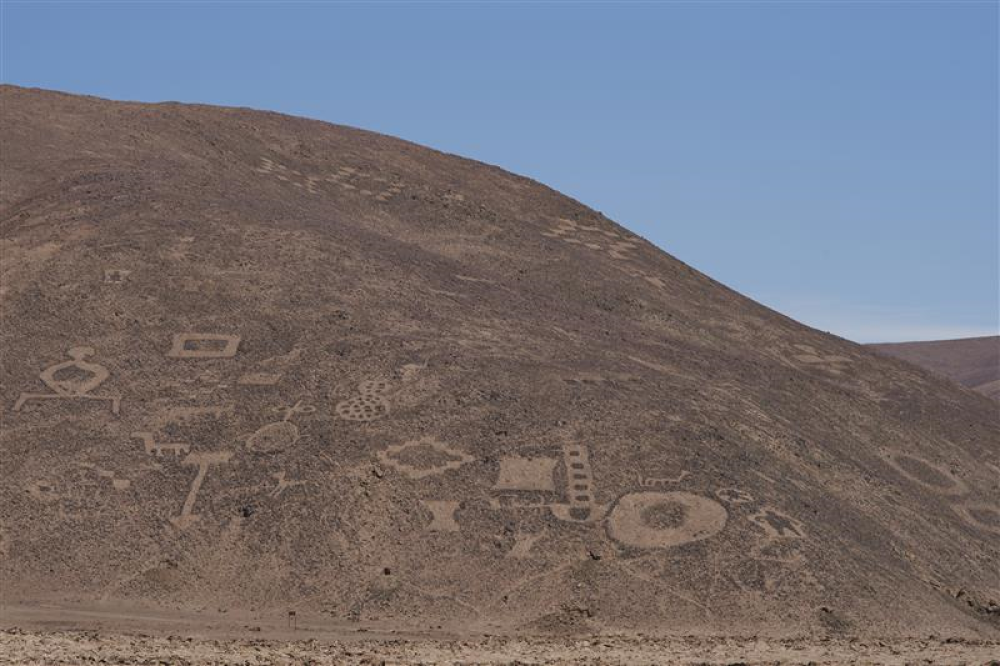The Atacama Desert in Chile is a harsh environment. Yet, once upon a time, humans were traipsing across the landscape committing enormous drawings to the earth – drawings that would endure for thousands of years.
Today we know them as geoglyphs, and while they’re found in various sites across the globe, Atacama is home to the largest discovered to date that depicts a human-like figure. The Atacama Giant looks a bit like Weird Barbie when viewed from above, with stick limbs and a pointy headpiece, and sits on the slopes of Cerro Unitá, looking north-east.
In A Human Environment, published in 2020, Karsen Lambers of Leiden University’s faculty of archaeology states that the geoglyph “is the biggest human figure known to have been produced in prehistory.” It stretches for 119 meters (390) feet across the hillside, according to Chile’s Ministry of National Assets, which declared it a Protected National Asset in 2020. The Atacama Giant is just one of over 5,000 in the region that range between 1,200 to 500 years old, and countless more across the world.
The majority of geoglyphs are created using the “extractive” technique by scraping the oxidized surface layer away, resulting in a lighter design that contrasts against the darker surrounding material. Others are created using an “additive” technique that combines things like stones to create a sort of mosaic that’s darker than the surrounding material, and some geoglyphs combine both approaches.
Some of the geoglyphs in the Atacama Desert are more abstract in shape.
Image credit: Jeremy Richards / Shutterstock.com
Humans at the time of the creation of the geoglyphs in northern Chile didn’t have an easy life, and had to find creative solutions for surviving in such a harsh environment. They needed llamas to help them get around, working out where life-saving water sources were as they traveled.
As they traversed the landscape they pieced together a complex network of paths, and – incredibly – still found the time to commit enormous geoglyphs to the ground. It’s expected they held great cultural and religious significance, but exactly the purpose and meaning of the Atacama Giant isn’t currently known.
“Some say that the ‘Atacama Giant’ contains possible alignment to solar eclipses and lunar phases,” explained Marika Labas of the University of New Hampshire in a 2012 article. “Supposedly, each of the four spikes protruding from the giant’s head will align with the sun or the moon during specific times of year. Others have even suggested that they were created by other-worldly visitors.”
When you step back, you get a better idea of the sheer size of the Atacama Giant.
Labas turned to local residents to gain further context, and was told by one person:
“Considering the existing limitations at the time it was built, the ‘Giant of Atacama’ has succeeded to stand strong for centuries, which makes me think the message it contains was a very relevant one for the former inhabitants of the Atacama Desert, and surely there is still something valuable for the coming generations to decipher.”
As the largest geoglyph in the world that depicts a human-like figure, the Atacama Giant has certainly turned heads, but year after year we’re getting more geoglyph material to work with. A giant 2,000-year-old cat among the Nazca lines was discovered in Peru back in 2020, and in 2023, the largest known cat geoglyph in Chile was identified as the endangered Andean cat.
Who knows what the desert winds will turn up next?
Source Link: A Colossal 119-Meter Giant Stretches Across The Atacama Desert, The Largest Of Its Kind
